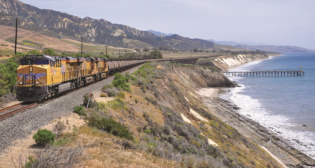
AAR: U.S. freight traffic rallies as February ends
Written by Douglas John BowenU.S. freight rail traffic was mixed over the 28 days of February, but advanced in the final days of the month included in the latest tally offered by the Association of American Railroads for the week ending March 1, 2014.
AAR reported Thursday, March 5, that U.S. freight carload traffic rose 1.4% for the week ending March 1, measured against the comparable week in 2013 and the second straight weekly gain. U.S. intermodal volume did better, up 3.4% for the week, also logging a second straight weekly gain. Total U.S. rail traffic for the week was up 2.3% over the comparable week in 2013.
Just four of the 10 carload commodity groups AAR measures on a weekly basis posted increases, however, led by grain, up 14.3%. Declining commodities included metallic ores and metals, down 5.2%.
Canadian freight carload traffic fared less well during the week ending March 1, down 11.8% compared to a year ago. Canadian intermodal, by contrast, advanced 3%. Mexican freight carload traffic fell 2.6% for the week compared with the same week a year ago; Mexican intermodal also declined, down 11.9%.
Combined North American freight carload traffic for the first nine weeks of 2014 on 13 reporting U.S., Canadian, and Mexican railroads remained in the minus column, down 1.8% percent compared with the same period in 2013. Combined North American intermodal volume was in the plus column, up 0.8%.
For the month of February itself, U.S. freight carload traffic declined 1.1%, while U.S. intermodal volume retained its winning ways, up 1.1%. Nine of the 20 commodity categories tracked by the AAR each month saw year-over-year carload increases in February over the same month last year, including grain, up 12.3%, and grain mill products, up 10.1%.
Coal continued to lag, down 3.5% during the month. Primary metal products also fell, down 7.2%.
“It would be nice to be able to separate out the effects of the harsh winter on rail traffic, but we can’t do that. We can probably expect improvements in the rail numbers in the months ahead, assuming that the weather and the economy cooperate,” said AAR Senior Vice President John T. Gray.
“In the meantime, crude oil has become a significant part of the railroad business. Railroads know how important it is to move crude oil safely, and they are committed to continually searching for ways to make this happen,” Gray said.



